|
The
Model 71 Winchester was the culmination of the large-frame leverguns produced by
the famed old company. Introduced in 1936 it was an upgrade of the famous Model
1886. Designed to make manufacturing a bit easier with improvements to handle
the new cartridge that was introduced with it, this was the last of the
big-frame leverguns made by Winchester.
The Model 1886 was
designed during the black powder era for large black powder cartridges.
Chambered for a variety of calibers including the .45-70, the Model 1886, was
adapted to a new smokeless powder medium bore cartridge called the .33 WCF in
1902. The .33 Winchester was intended for hunting large North American game and
used .338" diameter bullets, the same size used in today's .338 Magnums.
However, by the 1930's the .33 WCF was looking a bit underpowered. That and the
increased costs for the production of the 1886 (along with the slowdown of the
economy) had Winchester looking around at ways to cut costs in the production of
the big lever-action.
THE
RIFLE
A redesign of many
of the internal parts along with the introduction of a new caliber was
Winchester's plan to get the costs down and to market the package. The
redesigned '86 was renamed the Model 71 and the rest, as they say, is history.
The rifle was produced in only one caliber, the .348 WCF and it is the only
factory rifle ever chambered for this round.
It was introduced
in two different models, the Standard and the Deluxe versions and was produced
in 2 barrel lengths, 20" and 24" (carbine & rifle). Both models used a
pistol-grip stock. The Deluxe version had checkering on the forend and stock,
along with snap-on sling swivels, pistol-grip cap and a really cool bolt mounted
aperture sight.
|
Winchester
Model 71 |
|
Rear Sight
on Deluxe Model |
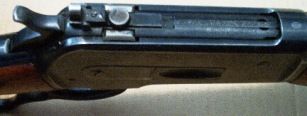 |
|
Browning 71 |
 |
By the mid-1950's
with costs again rising, the Model 71 was discontinued. Because all parts were
totally machined from steel (vs. cast as with most newer firearms) the rifle was
pretty expensive to produce. Too expensive to build and still make a profit. In
1956 Winchester stopped it's production and the last big levergun was no more.
About 47,000 of the Model 71's were made during it's 20 year history.
In 1987 Browning
produced a modern version of the Model 71 that was made in Japan. These have
different thread sizes in places, most notably the barrels, and many parts will
not interchange with the originals. The Browning version was a limited
production model only.
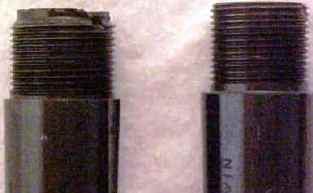 |
|
Left -
Winchester Model 71 barrel |
|
Right -
Browning Model 71 barrel |
THE
CARTRIDGE
The 348 was based
on the old .50-110 WCF cartridge and is the largest-sized rim diameter used in
factory leverguns. Original loadings for the .348 were in 2 different bullet
weights: 150 gr. and 200 grain jacketed. (The 250 gr. loading was added later
on.) The velocity's listed originally for the 150 gr. and 200 gr. loads were
2920 fps and 2535 fps. These were later reduced to 2890 for the 150 gr. and 2530
for the 200 grain loads. The 250 gr. loading which was introduced some time
after the 150 gr. and 200gr. loads was rated at 2350 fps.
 |
| Top - .30-30 Winchester |
| bottom - .348 Winchester |
 |
| Cartridge dimensions |
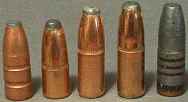 |
|
Left to
Right |
|
Old Winchester 200 gr. |
|
Hornady 200 gr. |
|
Barnes 250 gr. |
|
Alaskan Bullet Works 250 gr. |
|
250 gr. cast gas check |
Only the 200 gr.
factory load is produced today by Winchester.
Buffalo Bore, a small custom ammunition
company in Idaho, offers a High Velocity 250 gr. loading.
Handloaders do not
have a large selection of bullets to choose from. Hornady makes a 200 gr. JSP
bullet. Barnes produces a 220 gr. and a 250 gr. bullet. Alaska Bullet Works
makes a 250 gr. bullet also. This is the bullet that Buffalo Bore uses in their
.348 ammunition. Limited testing that I have done shows this to be a tough
bullet that should work well on large and/or dangerous game.
There are several bullet molds available for the .348" diameter projectile. I
don't know of too many people who use this caliber, let alone cast bullets for
it. I have used the gun for some years and even though I have a bullet mold and
dies, I have yet to run cast bullets in the gun. As little as I use it I prefer
my own handloads with jacketed ammo. Most of the game I have taken with it have
been with original Winchester 200 gr. Silvertips. I know that on large Mule Deer
the Winchester loading worked just fine.
LOADS
| Cast
bullet |
powder and |
|
|
sized .348" |
charge |
velocity |
|
Lyman
#350447 |
IMR 3031 35 gr. |
1818 |
|
187gr. |
IMR 3031
47 gr. |
2338 |
| |
IMR 4198
25 gr. |
1672 |
| |
IMR 4198
35 gr. |
2150 |
|
Lyman
#350482 |
IMR 3031 35 gr. |
1798 |
|
255 gr. |
IMR 3031 46 gr. |
2217 |
| |
IMR 4198 27 gr. |
1661 |
| |
IMR 4198
38 gr. |
2096 |
|
Jacketed bullet |
|
|
|
200 gr. Winchester |
Powder and |
|
|
JSP - OAL 2.78" |
charge |
Velocity |
| |
IMR
4198 34.5 gr. |
2100 fps |
| |
IMR
3031 43.0 gr. |
2200 fps |
| |
IMR 4320 52.0 gr. |
2470 fps |
| |
IMR 4064 53.6 gr. |
2535 fps |
|
Above tables are from early |
|
Lyman Reloading Manuals |
| |
|
With a 200 yard zero you can basically hold "on" to 250 yards. |
|
That is further than I would take a shot at game animals,
using the iron sights. |
|
To be fair the to animal I would stalk
|
|
closer. |
| |
BALLISTICS
Ballistically .. at least on paper .. the .348 Winchester falls somewhere
between the .350 Remington Magnum and the .358 Winchester I say "on paper" since
in real life the paper figures do not always turn out to be totally true. For
all practical purposes the .358 gives identical performance as the .348
Winchester.
|
Velocity Comparisons |
| |
|
|
100 |
200 |
300 |
400 |
500 |
|
caliber |
load |
muzzle |
yards |
yards |
yards |
yards |
yards |
|
348 WCF |
200 gr. Silvertip |
2520 |
2215 |
1931 |
1672 |
1443 |
1253 |
| |
200 gr. Silvertip |
2490 |
2171 |
1876 |
1610 |
1379 |
1194 |
|
350 Rem |
200 gr. Corelokt |
2710 |
2410 |
2130 |
1870 |
1631 |
1421 |
|
Trajectory Comparisons with a
200 yard Zero |
| |
|
|
100 |
200 |
300 |
400 |
500 |
|
caliber |
load |
muzzle |
yards |
yards |
yards |
yards |
yards |
|
348 WCF |
200 gr. Silvertip |
-.9" |
+3.7" |
0 |
-13" |
-53.3" |
-99.2" |
|
358
|
200 gr. Silvertip |
-.9" |
+3.8" |
0 |
-13.7" |
-40.9" |
-86.3" |
|
350 Rem |
200 gr. Corelokt |
-.9" |
+3.1" |
0 |
-10.8" |
-31.6" |
-65.4" |
| |
|
|
|
|
|
|
|
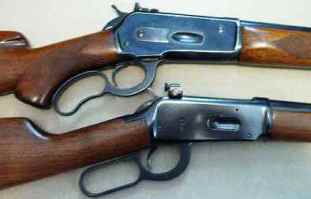 |
|
Model 71 & Model 94
Winchester's compared
side (above) &
top views (below) |
|
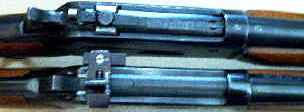 |
|
Below - Model 71 & Model 94
Win. compared open action |
|
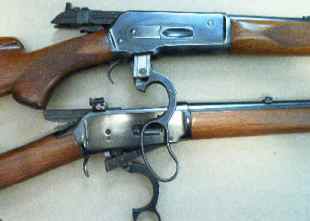 |
I have used the
.348 and the Model 71 Winchester to make good hits on targets to 800 yards.
While the paper ballistics would have you to believe that the trajectory would
make it impossible to do, in actual practice the gun and ammo work pretty well
for long-range rock busting.
I used handloads
with the 250 gr. Barnes Original bullet and found them to work very well at
extreme distances. One June I was in Cody, WY with The Shootists, shooting
targets from 300 to 800 yards using the above loads. Dick Casull was watching me
and I asked him if he wanted to take a shot. He took my rifle, asked where I was
holding on the 800 yard target, and proceeded, offhand, to hit the target! He
handed the rifle back to me and said quietly, "There are no flies on that one."
HUNTING
I have not hunted
with the Model 71 all that much. I have shot some coyotes and deer with it. I
used it in Arizona while hunting horseback and shot Mule Deer and Coues Deer
with it. In Missouri I have used it to hunt and take Whitetail Deer. I found the
Hornady 200 gr. bullets too tough to expand well on the smallish Whitetails in
S/W Missouri. The Winchester Silvertip bullet is much better on deer. The
Hornady and Barnes bullets are better suited for larger game... I would say, Elk
and larger/heavier animals. I haven't tried the Alaska Bullet Works bullets on
game but from limited testing I would say they fall into the same category as
the Barnes bullets, great for Big Game.
HOT-RODDING
IT
The
Model 71 has been used as a basis for caliber conversions over quite a few years
now. P.O. Ackley's .348 Improved was made by blowing the case out straight to
get rid of the tapered body. Combined with Ackley's sharp shoulder, case life
was dramatically improved over the factory cartridge and ballistics were
increased. Standard loads in the Improved case gave up to 500 fps increase over
the unmodified cartridge with some loads.
Bob Hutton (who
was at Guns & Ammo at the time) developed a series of wildcat cartridges based
on the Ackley Improved .348. There was a .30 caliber design called the .30-348,
the case being necked to .30 caliber. There was also a .35-348 (which proved to
be the most efficient of all the conversions), a .40-348, and a .450-348. The
.450-348 proved a very powerful cartridge, running a 350 gr. bullet at nearly
2500 fps and 400 gr. bullet at 2300 fps... very close to .458 Winchester Magnum
ballistics from a levergun. It was noted for tearing the magazine tube off the
rifle during recoil unless a special fixture was attached to hold the magazine
in place.
The
.450 Alaskan was developed around the same time. The only difference between it
and the .450-348 was the latter is the straight-walled Ackley design while the
.450 Alaskan has about a .020" body taper. It is noticeably smaller at the
shoulder than the Ackley cartridge. The .450 Alaskan has slightly reduced
ballistics when compared to the Ackley design, but because of the slight taper
the cartridge feeds better in the levergun.
Today the .50
Alaskan is a very popular conversion of the .348 Winchester cartridge. Blown out
to a straight case, the big gun hits hard on both ends! Regan Nonneman of
Nonneman Custom Rifles is a premier
builder of these big bores, as are a few other custom lever-smiths around the
country.
FINI
For my use the big
levergun is fine just as it came from the factory. It has all the power I will
need for what I use it for. I would have no hesitation using it for most any of
the large North American game animals. While it never caught on with the public
like the .30 or .35 calibers - most likely due at least in part to it's odd
caliber - the .348 is a very good one for those who like to play with cartridges
that are a bit different.
The
rifle that was built for it - the Model 71 Winchester - remains an excellent
example of what was being produced by gun companies during the days when
craftsmanship was put into the "assembly line" firearms.
|
|